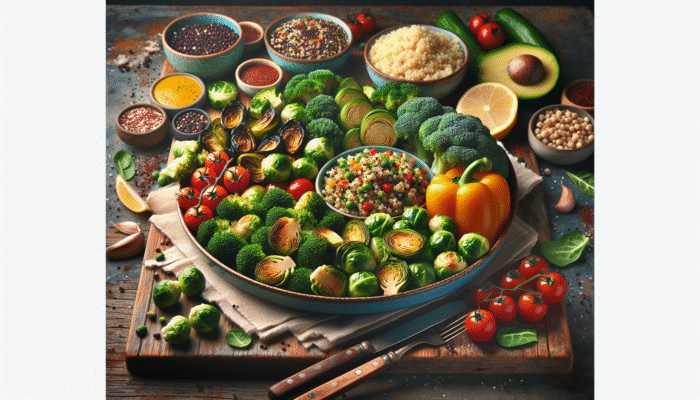Key Strategies for Choosing the Best Meats for Grilling
Select Lean and Nutritious Meat Cuts for Health-Conscious Grilling

Embarking on the journey of grilling for diabetic-friendly BBQ necessitates a thoughtful approach in selecting the most suitable meats. Focusing on lean cuts, like chicken breast and turkey, not only serves as a better health choice but also plays a pivotal role in managing diabetes effectively. These lean proteins are lower in saturated fats, aiding in the regulation of cholesterol levels and promoting overall heart health, which is especially crucial for those living with diabetes.
When preparing for your grilling session, prioritise boneless, skinless chicken breast during your shopping excursions. This cut cooks rapidly, absorbs marinades exceptionally well, and elevates the dish's flavour without adding unnecessary fats. Furthermore, don’t overlook the versatility of turkey; it's an excellent protein choice. Ground turkey can be crafted into delectable, juicy burgers, while turkey tenderloins remain succulent and flavourful when grilled. Both options are rich in protein, essential for maintaining muscle mass and fostering a stable metabolism.
Another critical aspect to consider is portion control. The ideal serving size of meat is around three ounces, approximately the size of a standard deck of cards. Keeping track of portion sizes is essential to prevent spikes in blood sugar levels while still enjoying the delightful grilled flavours. Remember, the type of meat you choose is just as important as the quantity you serve on your plate.
Would You Prefer to Listen to This Guide?
Perfect Portion Control for Improved Health and Blood Sugar Regulation
The significance of portion control cannot be emphasised enough when you’re grilling for diabetic-friendly BBQ. A common hurdle arises during social gatherings, where the urge to overload plates with grilled meats can be quite compelling. Practising mindful eating enables you to savour every flavour while effectively managing your blood sugar levels.
Utilising visual cues can substantially assist your portion control efforts. For example, using smaller plates creates an illusion of abundance while ensuring your serving sizes remain within recommended limits. Additionally, consider pre-portioned meats before grilling; this guarantees you are aware of exactly how much you’re consuming and helps maintain a balance with healthy side dishes.
Incorporating high-fibre foods into your meals can further enhance blood sugar management. Fibre slows down the absorption of glucose into the bloodstream, which is critical for maintaining stable blood sugar levels. While relishing that mouth-watering grilled chicken, remember to pair it with colourful vegetables or a nutrient-rich salad to maximise your health benefits.
Boost Your BBQ Flavours with Healthy Marinades and Spice Blends
The difference between a mediocre meal and a flavourful dish frequently lies in the marinades and rubs you select. When mastering how to grill for a diabetic-friendly BBQ, choose sugar-free marinades and spice blends that allow you to infuse your meats with robust flavours without jeopardising health.
Consider crafting your homemade marinades using ingredients such as olive oil, vinegar, fresh herbs, and spices. These ingredients not only enhance taste but also support stable blood sugar levels. For instance, a blend of balsamic vinegar, minced garlic, and rosemary can elevate grilled chicken to gourmet heights.
Rubs can also offer an exciting way to create flavourful dishes. A combination of paprika, cumin, and crushed garlic delivers a zesty kick that accentuates the natural flavours of any meat. The key is to emphasise herbs and spices instead of depending on sugary or high-carbohydrate components.
Moreover, marinating your meats for a few hours or even overnight allows flavours to permeate deeply and tenderise tougher cuts. The end result? Juicy, flavourful meats that align perfectly with your health objectives.
Wholesome and Tasty Side Dishes to Enrich Your Meal

Colourful Grilled Vegetables to Complement Your BBQ Feast
When exploring how to grill for diabetic-friendly BBQ, the side dishes you opt for can significantly enhance your overall meal experience. Grilled vegetables add vibrant colours and visual appeal, while being packed with essential nutrients and low in carbohydrates. Imagine the delightful flavours of perfectly charred bell peppers, zucchini, and asparagus; their tastes dance on your palate while assisting in maintaining healthy blood sugar levels.
To achieve that perfect grilling texture, lightly coat your vegetables in olive oil before grilling. This method prevents sticking and enhances their natural sweetness. Season them with fresh herbs like thyme or basil for an extra burst of flavour without additional calories.
Additionally, think about variety! Combining different coloured vegetables not only looks appealing but also ensures you consume a wide range of vitamins and minerals. For instance, while red bell peppers are rich in vitamin C, green zucchini provides valuable fibre. Together, they create a visually stunning plate that is both tasty and nutritious.
Grilling vegetables truly transforms their flavours. The high heat caramelises their natural sugars, yielding an intense taste that pairs beautifully with any grilled meat. Therefore, feel free to be generous with your vegetable sides; elevate your BBQ experience by filling your plate with these delightful options.
Creating Light and Refreshing Salads for Nutritional Harmony
Salads often serve as the unsung heroes of any BBQ, especially when you are mastering how to grill for diabetic-friendly BBQ. They provide a refreshing balance to grilled meats and can be customised in countless ways to meet your dietary preferences. Start with leafy greens as your base; selections like spinach, kale, or a mix of arugula and romaine deliver a nutrient-dense foundation.
Exercise caution with dressings, as they can hide added sugars. Rather than opting for store-bought varieties that may contain hidden sugars, create a simple vinaigrette using olive oil and vinegar or lemon juice. A sprinkle of herbs or a dash of mustard can elevate the flavour without compromising your health.
Incorporate colourful vegetables such as cherry tomatoes, cucumbers, and radishes for added crunch and nutrition. For a protein boost, consider adding grilled chicken or chickpeas, both of which complement your greens beautifully while assisting in maintaining stable blood sugar levels.
The essence of a great salad lies in its balance and diversity. Experiment with textures and flavours by adding nuts or seeds for that extra crunch. By crafting unique salads, you’ll not only satisfy your guests but also ensure a well-rounded meal that perfectly fits your diabetic-friendly BBQ theme.
Incorporating Whole Grains for Enhanced Nutritional Value

Integrating whole grains into your menu is vital for a balanced diabetic-friendly BBQ. Selections like quinoa, brown rice, and farro are nutritious options that seamlessly fit into your grilling repertoire. These whole grains are packed with fibre, essential for regulating blood sugar levels.
Quinoa is particularly noteworthy for its health benefits. It is gluten-free and contains all nine essential amino acids, making it an outstanding protein source. Tossing cooked quinoa with grilled vegetables and a light dressing results in a delightful side dish that is both filling and flavourful.
Brown rice is another excellent addition. Pair it with grilled chicken and a splash of low-sodium soy sauce for a simple yet satisfying meal. The fibre in brown rice aids in slowing digestion, resulting in more stable blood sugar levels after consumption.
Farro, an ancient grain, imparts a nutty flavour and chewy texture that can enhance any dish. Serve it warm alongside your grilled meats, mixed with fresh herbs and lemon for a refreshing twist. Whole grains can add versatility and nutrients to your BBQ spread, ensuring your guests leave feeling nourished and content.
Enhancing Your Menu with Nutrient-Rich Steamed Greens
While grilling often takes centre stage, don’t underestimate the importance of including steamed greens in your how-to-grill for diabetic-friendly BBQ repertoire. Greens such as spinach, kale, and Swiss chard are low in calories yet rich in vitamins and minerals that support overall health and well-being. Steaming retains their nutrients and enhances their natural flavours, making them an ideal side dish.
To steam greens, place them in a steamer basket over boiling water for a few minutes until they wilt. A drizzle of olive oil or a squeeze of lemon can enhance their flavour without adding unwanted calories.
You can also incorporate seasonings such as garlic powder or crushed red pepper for an extra flavour boost. These enhancements ensure your greens are not only nutritious but also bursting with flavour, making them a delightful accompaniment to grilled meats.
Including steamed greens in your BBQ menu is an excellent way to provide essential nutrients. They’re simple to prepare and can be seasoned to fit any flavour profile, making them a versatile choice for your summer grilling.
Delicious Roasted Root Vegetables to Enrich Your BBQ Spread
Roasted root vegetables provide a wonderful means to introduce depth and sweetness to your BBQ offerings. When considering how to grill for diabetic-friendly BBQ, think of carrots, beets, and sweet potatoes as your go-to options. These vegetables are nutrient-rich and have a low glycemic index, making them suitable for those managing diabetes.
Roasting enhances their natural sweetness, bringing forth flavours that harmonise beautifully with grilled meats. Toss them in olive oil, salt, and pepper, and roast until tender and caramelised. The result is a dish that satisfies hearty cravings while being undeniably nutritious.
Mixing different varieties of root vegetables creates a colourful and visually appealing side dish. Imagine a platter filled with golden roasted carrots, vibrant red beets, and creamy sweet potatoes. This assortment not only looks stunning but also provides a spectrum of vitamins and minerals essential for a balanced diet.
Additionally, roasted root vegetables can be prepared ahead of time, as they hold up well at room temperature, making them a perfect addition to your BBQ spread.
Refreshing Beverage Choices to Enhance Your BBQ Experience
Choosing Sugar-Free Drinks for Optimal Health and Enjoyment
When selecting beverages for your BBQ, making informed choices is crucial for supporting your health journey. Opt for sugar-free drinks that refresh and help maintain stable blood sugar levels. Water remains the best option. Infusing it with slices of cucumber, lemon, or berries can make hydration more enjoyable.
Unsweetened iced tea is another excellent choice. Brew your preferred tea—whether green tea, black tea, or herbal varieties—and chill it for a refreshing drink rich in antioxidants. Adding a splash of lemon juice or a few mint leaves can elevate the flavour without introducing sugars.
For a unique twist, consider creating a signature sugar-free mocktail. Combine sparkling water with muddled fruits and herbs for a drink that is both flavourful and enjoyable. This way, everyone can partake in a toast without compromising their health goals.
Avoid sugary sodas and energy drinks, as these can lead to blood sugar spikes. Choosing sugar-free alternatives ensures your BBQ maintains its diabetic-friendly status while keeping everyone refreshed and satisfied.
Invigorating Low-Calorie Beverage Ideas for Your Guests
As you delve into grilling for diabetic-friendly BBQ, don’t overlook low-calorie beverage options that keep your gatherings light and refreshing. Diet sodas can serve as a convenient option for flavour without the calories; however, be cautious of the artificial sweeteners they contain. Always check labels for hidden carbs or sugars.
Flavoured waters present another excellent choice. These beverages offer a burst of flavour without added calories. Create your own by infusing still or sparkling water with slices of fruits or herbs. A touch of creativity can transform a simple drink into a delightful refreshment that all your guests will appreciate.
Additionally, consider serving low-calorie cocktails, such as a simple vodka soda with a twist of lime. These lighter options allow you to enjoy a drink guilt-free while remaining social.
To cater to diverse preferences, provide a variety of low-calorie options at your BBQ. This ensures everyone feels included while adhering to healthy guidelines.
Mindful Alcohol Choices for Your Gathering
If you plan to serve alcohol at your BBQ, moderation is key, especially when navigating how to grill for a diabetic-friendly BBQ. Make thoughtful selections that support your health goals. Light beers or dry wines are excellent choices, as they tend to be lower in carbohydrates and sugars compared to heavier options.
Be mindful of portion sizes; a standard drink is typically defined as 12 ounces of beer, 5 ounces of wine, or 1.5 ounces of distilled spirits. Sipping these beverages in moderation helps prevent sudden blood sugar spikes, ensuring your BBQ remains enjoyable and safe.
Encourage guests to hydrate alongside their alcoholic beverages. Providing water or low-calorie mixers helps everyone stay refreshed while minimising overall caloric intake.
Lastly, create a fun atmosphere that doesn’t rely solely on alcohol. Offer unique, non-alcoholic drinks that everyone can enjoy, fostering a healthy environment where all feel included in the festivities without compromising their health.
Proven Grilling Techniques for Successful Outcomes
Understanding Direct vs. Indirect Heat for Perfect Grilling Results
Mastering the grill requires a solid understanding of heat management. The difference between direct and indirect heat can significantly influence how you grill for a diabetic-friendly BBQ. Direct heat is perfect for quickly cooking items like burgers and chicken breasts. This method allows for a beautiful sear while locking in moisture. However, be cautious—excessive direct heat can lead to charring, which may produce harmful compounds.
Conversely, indirect heat is a game-changer for larger cuts of meat or vegetables. This method involves cooking food away from the flames, allowing for even cooking without the risk of burning. Think of it as slow-roasting on the grill. A whole chicken or a beef brisket benefits from low and slow cooking, resulting in tender, juicy meat.
Combining both methods can elevate your grilling experience. Start with direct heat to sear your meat, then transition to indirect heat for thorough cooking without burning. This technique preserves moisture and flavour while minimising harmful compound formation.
Grasping these methods opens the door to countless grilling possibilities. Mastering heat management ensures every dish not only tastes fantastic but is also healthier for you and your guests.
Maintaining Temperature Control for Optimal Cooking Results
Temperature control is vital for mastering the art of grilling, particularly when exploring how to grill for diabetic-friendly BBQ. Consistency is key! A stable grill temperature ensures even cooking, which is essential for both flavour and food safety.
Investing in a reliable grill thermometer can make a significant difference. Ideal grilling temperatures typically range between 350°F and 450°F for most meats. For chicken, aim for an internal temperature of 165°F, while red meats should reach at least 145°F to ensure safe consumption.
Keep in mind that different meats require varying cooking times. A thick steak might need higher temperatures and quicker cooking, while a whole chicken benefits from a lower, slower approach. Adjusting your grill settings accordingly will yield tender and flavourful results while avoiding burnt exteriors.
Employing a two-zone fire setup can effectively manage temperature. This method creates a hot side for searing and a cooler side for thorough cooking. It enhances your grilling outcomes and provides greater versatility in your cooking techniques.
Minimising Excessive Charring for Healthier Grilling Outcomes
While charred meat may seem appealing due to its smoky flavour, it’s essential to avoid excessive charring when learning how to grill for diabetic-friendly BBQ. Overcooking can generate harmful compounds, such as heterocyclic amines (HCAs) and polycyclic aromatic hydrocarbons (PAHs), which are linked to health risks.
To minimise charring, ensure your grill is clean before you start cooking. Residue from past cookouts can contribute to flare-ups and unwanted burnt flavours in your food. Additionally, flipping your meat frequently helps prevent char, allowing for even cooking without exposing any side to direct flames for too long.
Marinating your meats can also act as a barrier against charring. The sugar in marinades can caramelise and burn easily, but using low-sugar options helps retain moisture while enhancing flavour.
Lastly, monitoring cooking times and utilising a meat thermometer can help you achieve perfect grill marks without compromising on safety or health.
Marinating and Seasoning for Enhanced Flavour Experience
To elevate the flavour and tenderness of your grilled meats, marinating and seasoning are invaluable tools in your how-to-grill-for-diabetic-friendly-BBQ toolkit. Marinades not only impart flavour but also help keep proteins juicy, maximising taste without unnecessary calories.
Create a variety of marinades using acid-based ingredients, such as vinegar or citrus juices, combined with herbs and spices. These components help tenderise meat while adding layers of flavour. For instance, a marinade of lemon and rosemary can transform chicken into a culinary delight while retaining its health benefits.
Seasoning your meats with a blend of herbs and spices can enhance flavour without introducing sugar or calories. Paprika, garlic powder, and black pepper are excellent choices that can add depth to your dishes. Experiment with different combinations to create signature blends that excite your taste buds.
Allowing your proteins to marinate for at least an hour (or even overnight) enables the flavours to penetrate deeply, ensuring each bite is packed with deliciousness. This approach not only enhances flavour but also supports a healthier grilling experience.
Delicious and Nutritious Dessert Choices to Conclude Your Meal
Crafting Bright and Flavorful Fruit-Based Desserts for a Sweet Ending
Who says desserts must be sugary and heavy? When exploring how to grill for a diabetic-friendly BBQ, fruit-based desserts can offer a vibrant and satisfying conclusion to your meal. Grilling fruits like peaches, pineapples, and watermelons brings out their natural sweetness, intensifying their flavours without requiring added sugar.
Grilled peaches stand out as an excellent option—slice them in half, remove the pit, and grill them cut-side down. The result? A caramelised fruit that’s delightful on its own or paired with a dollop of Greek yogurt.
Pineapples also excel on the grill. Their tropical sweetness reaches new heights when cooked, making them a delightful addition to salads or enjoyable on their own.
Even watermelons can be transformed into a refreshing dessert. Grilling slices caramelises the sugars, resulting in a warm and juicy treat perfect for hot summer days. Serve with a squeeze of lime for an added zing.
These fruit-based desserts offer antioxidants and vitamins while keeping your sweet offerings healthy and satisfying.
Indulging in Guilt-Free Sugar-Free Treats
For those with a sweet tooth, sugar-free desserts can provide a delightful conclusion to your BBQ experience without guilt. When considering how to grill for diabetic-friendly BBQ, sugar-free ice creams and yogurts are fantastic choices that allow you to indulge without compromising your health.
Many brands now offer sugar-free frozen desserts made with natural sweeteners like stevia or erythritol. These treats deliver a creamy texture and delicious flavour without the carb overload typically associated with traditional ice creams.
Greek yogurt serves as another versatile option. It acts as an excellent base for parfaits, layered with berries and sprinkled with nuts for added crunch. This treat not only provides protein but also satisfies your sweet cravings without causing blood sugar spikes.
Don’t hesitate to experiment with homemade options! Try whipping up a sugar-free cheesecake or brownies using almond flour and natural sweeteners. This approach allows you to enjoy your favourite desserts while staying true to your dietary goals.
Maintaining Mindful Portion Sizes for Desserts
When it comes to desserts, controlling portion sizes is crucial, especially while navigating how to grill for diabetic-friendly BBQ. Keeping dessert portions small allows you to indulge without overindulging. Aim for bite-sized treats or mini portions that can satisfy your sweet tooth without overwhelming your blood sugar levels.
For example, consider serving individual fruit cups or small servings of ice cream in ramekins. This method not only aids in portion control but also adds a touch of elegance to your dessert presentation.
If you’re offering a variety of desserts, encourage guests to sample smaller portions of each one. This approach fosters a shared experience while allowing everyone to enjoy a range of flavours without excess.
Remember, enjoying dessert is all about finding balance. While it’s perfectly fine to indulge occasionally, being mindful of portions ensures that you can savour sweetness without compromising your health goals.
Exploring Low-Glycemic Dessert Options for Health
When considering dessert choices, focusing on low-glycemic options can enhance your how-to-grill experience for a diabetic-friendly BBQ. Low-glycemic desserts, such as those made with almond flour or dark chocolate, can satisfy your cravings without causing blood sugar spikes.
Almond flour is a fantastic alternative to traditional flour, offering a nutty flavour and lower carbohydrate content. Bake almond flour cookies or brownies for a guilt-free treat that’s rich and satisfying.
Dark chocolate, particularly varieties with 70% cocoa or higher, can be a delightful option. Rich in antioxidants, dark chocolate can satisfy cravings while providing health benefits. Consider serving small squares or melting it for dipping fruits.
Chia seed pudding is another fantastic low-glycemic dessert option. Combine chia seeds with unsweetened <a href="https://limitsofstrategy.com/almond-milk-health-benefits-the-creamy-superfood/">almond milk</a> and a splash of vanilla for a creamy, nutrient-rich treat. Top it with berries for added sweetness without the sugar.
By focusing on low-glycemic desserts, you can enjoy the pleasure of dessert while maintaining stable blood sugar levels. It’s all about making smart choices that align with your health objectives.
Utilising Natural Sweeteners for Healthier Dessert Options
When sweetening your desserts, natural sweeteners can transform your offerings, especially when learning how to grill for diabetic-friendly BBQ. Options like stevia and monk fruit provide sweetness without the calorie load or sugar spikes associated with traditional sweeteners.
Stevia, derived from the leaves of the Stevia plant, is a zero-calorie sweetener that can be used in various applications, including baked goods and beverages. Its natural origin makes it a fantastic choice for those looking to reduce sugar intake.
Monk fruit is another excellent option, offering sweetness up to 200 times greater than sugar while containing zero calories. It works wonderfully in desserts, creating a rich flavour profile without adverse effects on blood sugar.
When using natural sweeteners, remember that a little goes a long way. Experiment with different recipes to find the right balance for your palate.
Incorporating these natural sweeteners into your dessert offerings not only heightens flavour but also aligns with your health objectives. It’s all about embracing the joy of sweet moments while prioritising your well-being.
Monitoring Your Health and Making Necessary Adjustments
Regular Blood Sugar Monitoring for Effective Diabetes Management
Consistently checking blood sugar levels is crucial for managing diabetes, particularly when embarking on the journey to grill for diabetic-friendly BBQ. Monitoring your glucose levels empowers you to make informed dietary choices, ensuring you can relish your BBQ without concern.
Testing your blood sugar before and after meals provides insight into how various foods impact your levels. This practice not only helps you comprehend your dietary habits but also aids in effectively planning future meals.
Understanding how your body reacts to different foods allows you to adjust portion sizes or meal components as necessary. If specific dishes yield higher readings, consider modifying or replacing them with alternatives that better align with your health goals.
Encouraging your guests to monitor their blood sugar fosters a supportive atmosphere where everyone feels empowered to prioritise their health.
Collecting Feedback from Guests for Continuous Improvement
Feedback serves as a valuable tool for enhancement, especially when exploring how to grill for diabetic-friendly BBQ. Gathering input from your guests, particularly those with dietary needs, helps you refine your offerings for future gatherings.
After your BBQ, take a moment to ask for your guests' opinions on the food. What did they enjoy? Were there options they found particularly satisfying? This information will guide your planning for future events, ensuring you cater to everyone’s tastes while maintaining health standards.
Consider creating a simple feedback form or an informal survey. This can spark conversations about healthy eating and make your guests feel valued and listened to.
Moreover, be open to suggestions! Guests may provide unique insights or share recipes that fit well within the diabetic-friendly framework. This collaborative approach not only enriches your BBQ menu but also cultivates a sense of community around healthy eating.
Embracing Continuous Learning for Enhanced Grilling Techniques
The landscape of health and nutrition is ever-evolving, and staying informed about new diabetic-friendly recipes and grilling techniques can deepen your understanding of how to grill for diabetic-friendly BBQ. Regularly seeking resources, such as cookbooks, blogs, or cooking classes focused on diabetic-friendly cooking, can provide valuable insights.
Joining online communities or forums dedicated to healthy eating can also offer a wealth of knowledge. Sharing experiences and tips with like-minded individuals can inspire creativity in your grilling endeavours.
Experimenting with new ingredients or techniques during your BBQs can add excitement to the cooking process. Try various marinades and seasonings or explore new grilling methods. The more you learn, the more you can enjoy creating delicious meals that align with your health goals.
Continuous learning also sets a positive example for others. Sharing newfound knowledge with friends and family can spark discussions about health, cultivating a supportive environment at your BBQs.
Scheduling Regular Health Check-Ups for Ongoing Wellness
Scheduling periodic visits to your healthcare provider is essential for monitoring your overall health, particularly when focusing on how to grill for diabetic-friendly BBQ. Regular check-ups allow for comprehensive assessments of your blood sugar levels, cholesterol, and other vital health indicators.
During these appointments, discuss your grilling practices and dietary choices. Your healthcare provider can offer personalised advice based on your unique health needs, ensuring you’re making informed decisions during your BBQs.
Furthermore, maintaining an open dialogue about your experiences and challenges can yield valuable insights. If you’re trying out new recipes or techniques, sharing your successes and setbacks with your healthcare provider fosters a supportive relationship.
Ultimately, regular health check-ups support your journey toward better health, empowering you to enjoy your BBQs with peace of mind.
Frequently Asked Questions About Diabetic-Friendly BBQ
Which meats are best suited for a diabetic-friendly BBQ?
Opt for lean cuts such as chicken breast, turkey, or fish. These selections are lower in fat and calories, making them ideal for individuals managing diabetes.
Can I incorporate sugar substitutes into marinades?
Absolutely! Utilise natural sweeteners like stevia or monk fruit in marinades to enhance flavour without impacting blood sugar levels.
What healthy side dishes pair well with BBQs?
Delicious options include grilled vegetables, salads, whole grains, and steamed greens, all of which are nutritious and flavourful.
How can I ensure my drinks are sugar-free at a BBQ?
Provide water, unsweetened iced tea, or flavoured sparkling water to keep hydration tasty without causing sugar spikes.
What dessert options are suitable for individuals with diabetes?
Consider fruit-based desserts, sugar-free ice creams, and low-glycemic options, such as almond flour cookies, to satisfy your sweet cravings.
How can I prevent charring on meats while grilling?
Utilise indirect heat for larger cuts, maintain a clean grill, and monitor cooking times to avoid harmful charred areas.
Why is portion control important for people with diabetes?
Portion control is crucial for effectively managing blood sugar levels, ensuring meals are satisfying without excessive calorie intake.
How can I make my BBQ more inclusive for guests with diabetes?
Offer a variety of healthy options, provide clear labelling for foods, and gather feedback to improve future gatherings.
Is marinating necessary for grilling?
While not mandatory, marinades can enhance flavour and tenderness, making your grilled meats more enjoyable and delicious.
Should I include alcohol at my BBQ?
If you decide to serve alcohol, offer low-calorie options, such as light beers or dry wines, and promote moderation for healthier choices.
Connect with us on Facebook!
The Article How to Grill for Diabetic-Friendly BBQ: A Healthy Guide appeared first on https://pitmastersarsenal.com
The Article Grilling for Diabetic-Friendly BBQ: Your Healthy Guide Was Found On https://limitsofstrategy.com
The Article Diabetic-Friendly BBQ: A Healthy Grilling Guide found first on https://electroquench.com

